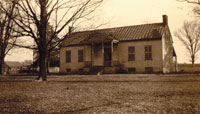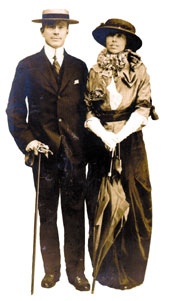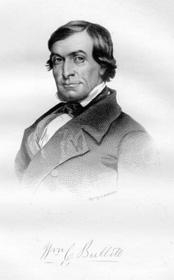The Bullitt Family Papers
By Shirley Harmon
Manuscript Cataloger
About |
 Eight miles east of downtown Louisville, nestled in St. Matthews among the shopping malls, residential developments, and two interstates, sits
Oxmoor, the home of the Bullitt family since the 1780s. Following the death of Thomas W. Bullitt in 1991, The Filson Historical Society became the home of the Bullitt Family Papers with the Oxmoor Trust at PNC Bank acting as manager. The papers, most of which had been gathered and filed by William Marshall
Bullitt, had been stored in various places on the Oxmoor property since the death of Marshall Bullitt in 1957. They had largely been untouched until they were put on deposit at The Filson in the fall of 1992.
Eight miles east of downtown Louisville, nestled in St. Matthews among the shopping malls, residential developments, and two interstates, sits
Oxmoor, the home of the Bullitt family since the 1780s. Following the death of Thomas W. Bullitt in 1991, The Filson Historical Society became the home of the Bullitt Family Papers with the Oxmoor Trust at PNC Bank acting as manager. The papers, most of which had been gathered and filed by William Marshall
Bullitt, had been stored in various places on the Oxmoor property since the death of Marshall Bullitt in 1957. They had largely been untouched until they were put on deposit at The Filson in the fall of 1992.
I n March 1999, I was contracted by The Filson to catalog the Bullitt Family Papers. As I began the daunting task (it took me a year simply to process the material and get it into order), the depth of this rich collection became apparent. The collection is the largest on deposit at The Filson, measuring approximately 160 cubic feet. The papers date from the 1760s to the 1990s and contain a wealth of information concerning Louisville’s pioneer days, the early settlers’ struggles with the Indians, Kentucky’s road to statehood, antebellum Louisville, the Civil War, the early twentieth century, and World War II.
 The family’s patriarch, Alexander Scott
Bullitt, was born in Dumfries, Virginia, and had been a representative to the House of Burgesses before he set off to Kentucky in 1784. A man of some wealth, Bullitt solidified his local landholdings with his marriage to Priscilla Christian, the daughter of William Christian, in 1786. As a wedding gift Christian gave his daughter and new son-in-law 1,000 acres of his 2,000-acre military land grant. The land was located north of modern-day Shelbyville Road. After Christian was killed by Indians in April 1786, a mere nine months after his arrival in Kentucky, Bullitt sold 500 of his 1,000 acres to his friend Benjamin Sebastian, who in turn sold Bullitt the land he owned south of Shelbyville Road. It is this land that would become the Oxmoor plantation.
The family’s patriarch, Alexander Scott
Bullitt, was born in Dumfries, Virginia, and had been a representative to the House of Burgesses before he set off to Kentucky in 1784. A man of some wealth, Bullitt solidified his local landholdings with his marriage to Priscilla Christian, the daughter of William Christian, in 1786. As a wedding gift Christian gave his daughter and new son-in-law 1,000 acres of his 2,000-acre military land grant. The land was located north of modern-day Shelbyville Road. After Christian was killed by Indians in April 1786, a mere nine months after his arrival in Kentucky, Bullitt sold 500 of his 1,000 acres to his friend Benjamin Sebastian, who in turn sold Bullitt the land he owned south of Shelbyville Road. It is this land that would become the Oxmoor plantation.
O ver the years, parcels have been sold and new ones added, but the essence of Oxmoor has remained. Alexander and Priscilla raised their four children in the original four-room clapboard structure constructed in 1790-1791. Upon Alexander’s death in 1816, he left the plantation to his youngest son, William Christian Bullitt. William worked as a lawyer for a few years, but following his marriage to Mildred Ann Fry in 1819, he began farming full-time. A brick addition was added to the house in 1829 to accommodate the Bullitts’ growing family. Bullitt and his family lived in the home and oversaw the plantation and numerous slaves for over forty years. However, faced with a dwindling slave population and with three of his sons off fighting in the Civil War, William decided to cease operations at Oxmoor, rent out the land, and move into the city.
 Upon William’s death in 1877, Oxmoor was divided among his six surviving children; however, no one inhabited the house for another forty years. In 1906, William’s grandson, William Marshall
Bullitt, began buying parcels of land from other family members and by 1909 he had moved into the house. Since that time a Bullitt has lived at
Oxmoor. Bullitt added two wings, one in 1915 and an expansive library wing in the mid-1920s.
Upon William’s death in 1877, Oxmoor was divided among his six surviving children; however, no one inhabited the house for another forty years. In 1906, William’s grandson, William Marshall
Bullitt, began buying parcels of land from other family members and by 1909 he had moved into the house. Since that time a Bullitt has lived at
Oxmoor. Bullitt added two wings, one in 1915 and an expansive library wing in the mid-1920s.
In addition to telling the story of the Bullitts and their historic home, the papers also reveal the importance of the Bullitt family in the history of our city, state, and nation. After Alexander Scott Bullitt relocated to Kentucky, his influence within the state flourished. He helped draft the state’s first constitution with George Nicholas in 1792 and was elected the state’s first lieutenant governor in 1800. The family’s correspondence with prominent families, such as the Binghams, Speeds, Logans, and Marshalls, emphasizes their importance locally, and it also illuminates the society of antebellum Louisville, reveals the role of women in the family, and sheds light on the everyday lives of the Bullitt slaves. Other documents, including letters from Patrick Henry, a land grant signed by Thomas Jefferson, Civil War correspondence from the three sons of William Christian Bullitt, and photographs from World War II, illustrate national figures and events.
The papers are presently being cataloged and scheduled for completion in March 2002. Because of the richness and wealth of information in this collection, it will quickly become one of the most used at The Filson.
The Filson Historical Society
1310 South Third Street - Louisville, KY
40208
Phone: (502) 635-5083 Fax: (502) 635-5086
Hours
The Ferguson Mansion and Office
Monday - Friday: 9 am. - 5 pm.
Saturday and Sunday closed
Library
Monday - Friday: 9 am. - 5 pm.
Saturday: 9 am. - 12 noon
